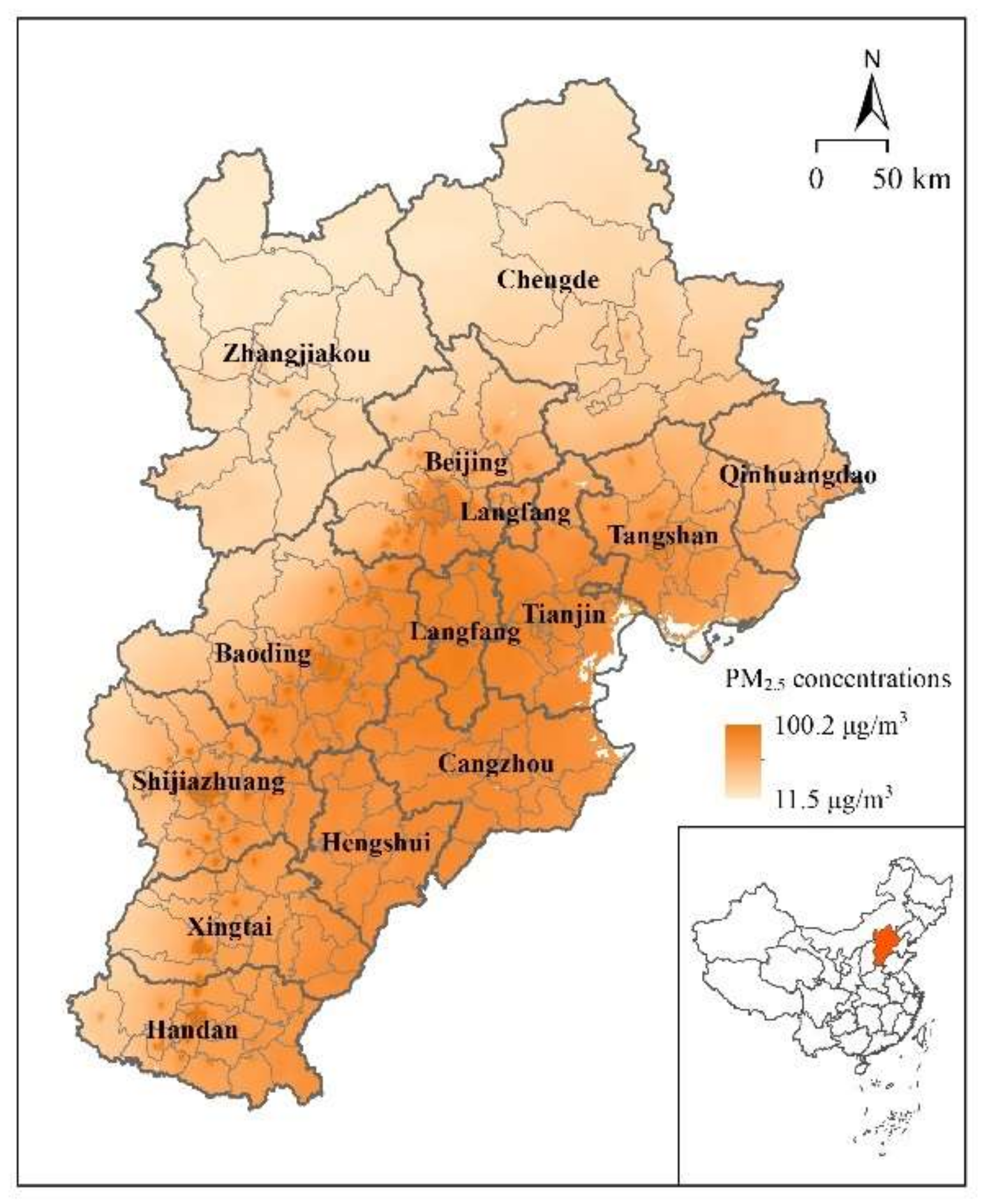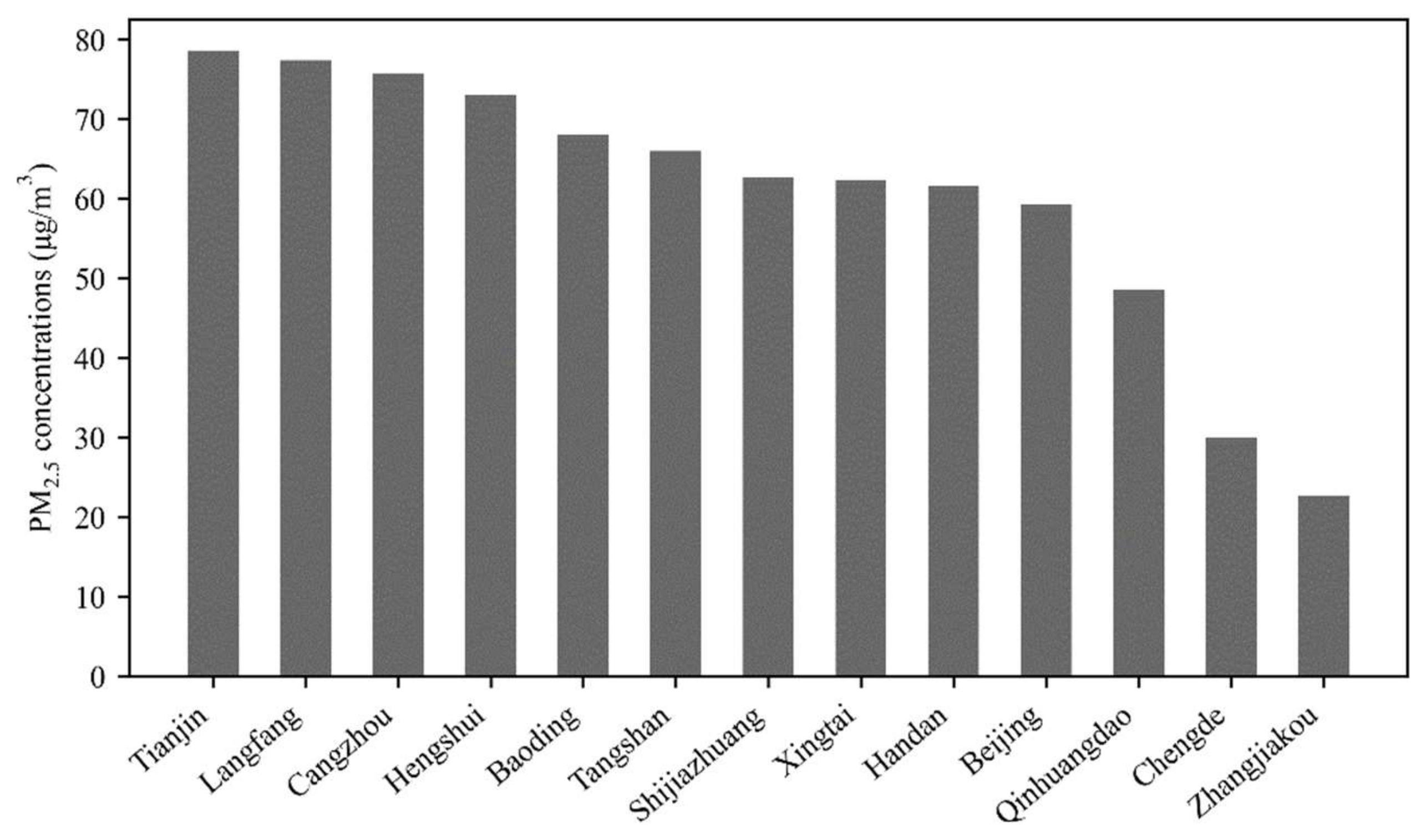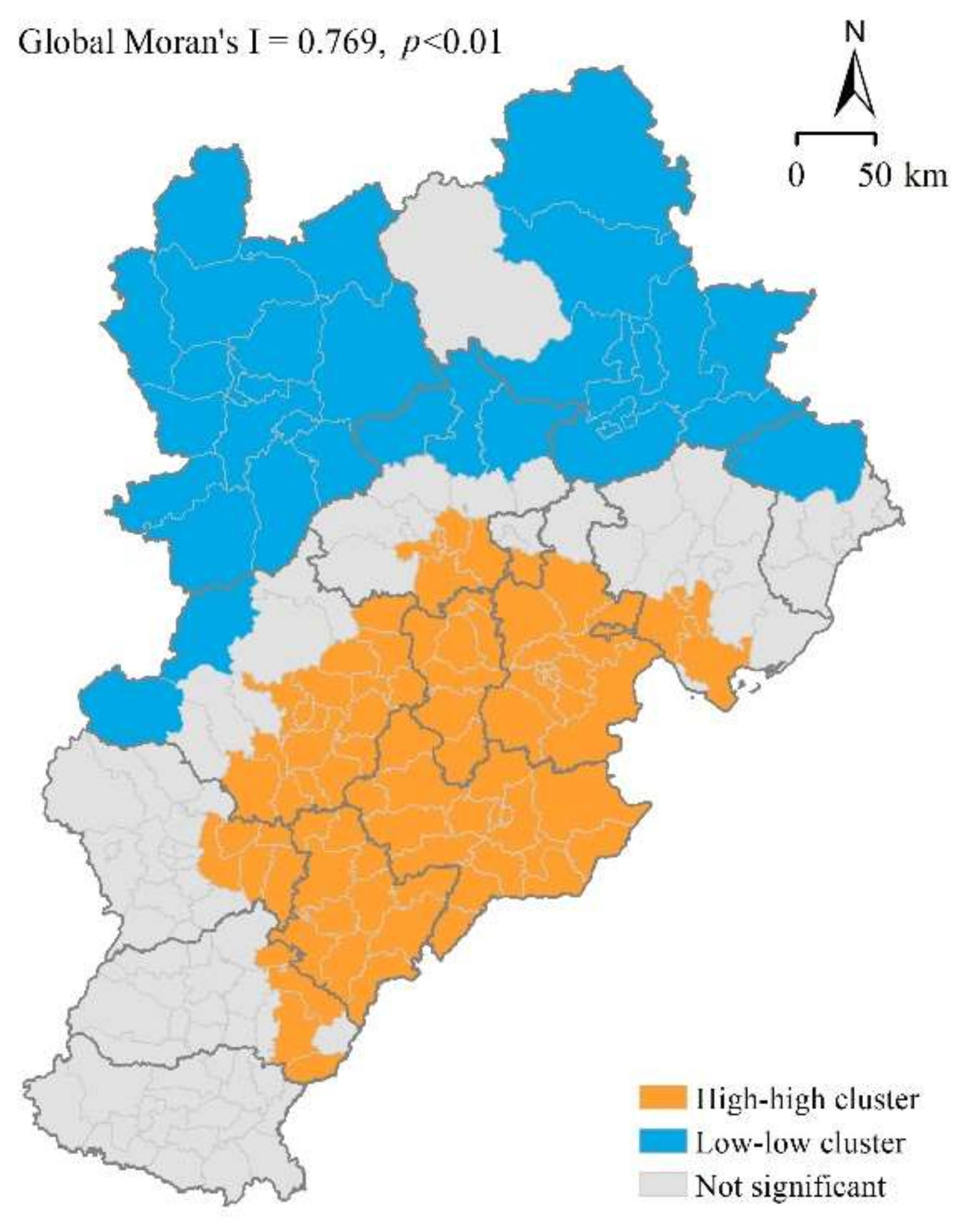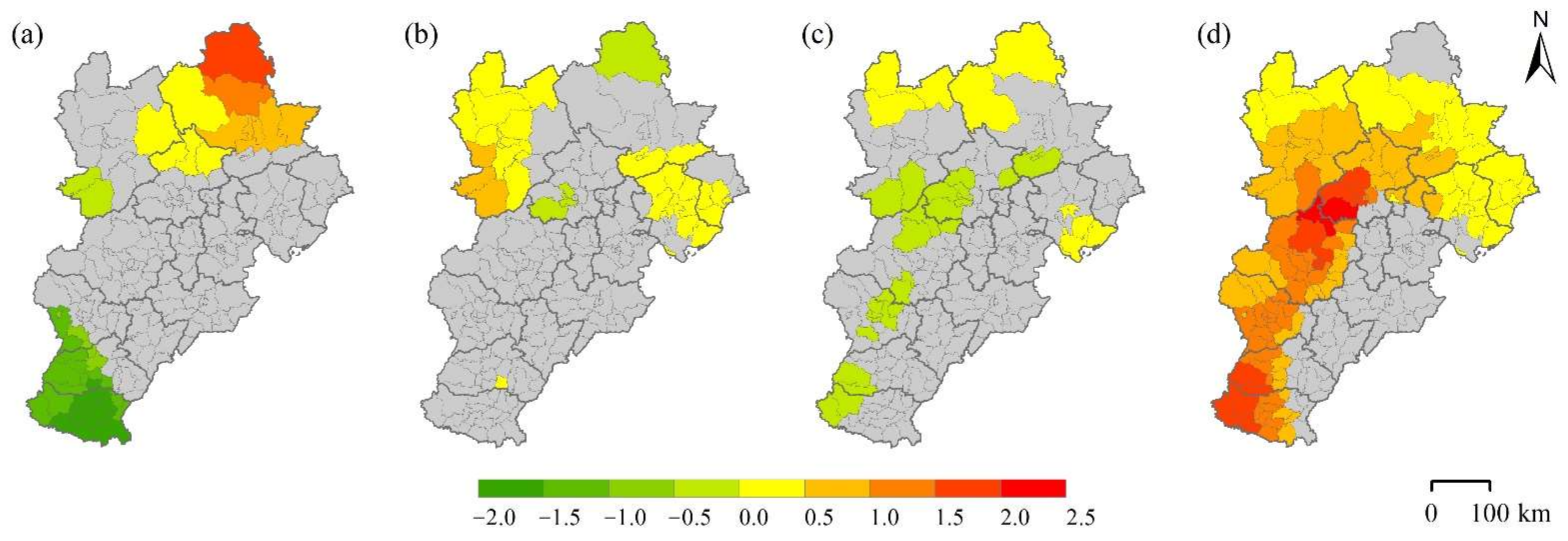Spatial Variation of the Effect of Multidimensional Urbanization on PM2.5 Concentration in the Beijing–Tianjin–Hebei (BTH) Urban Agglomeration
Abstract
:1. Introduction
2. Study Area
3. Data and Methods
3.1. Selection of Urbanization Indicators and Data Sources
3.2. Spatial Correlation Test
3.3. Geographically Weighted Regression Model
4. Results and Discussion
4.1. Spatial Pattern of PM2.5 Concentration
4.2. Global Regression Analysis
4.3. GWR Analysis
4.3.1. Spatial Correlation between Urbanization and PM2.5 Concentration
4.3.2. Classification of Counties and Policy Recommendations for PM2.5 Reduction
5. Conclusions and Limitations
Supplementary Materials
Author Contributions
Funding
Institutional Review Board Statement
Informed Consent Statement
Data Availability Statement
Acknowledgments
Conflicts of Interest
Abbreviations
| BTH | Beijing–Tianjin–Hebei |
| GDP | Gross domestic product |
| GWR | Geographically weighted regression |
| POP | Population |
| LPI | Largest patch index |
| PLADJ | Percentage of like adjacencies |
| LULC | Land use/land cover |
| RESDC | Data Center for Resources and Environmental Sciences of the Chinese Academy of Sciences |
| LISA | Local indicators of spatial association |
| OLS | Ordinary least squares |
| AIC | Akaike information criterion |
| VIF | Variance inflation factor |
References
- Zhu, Y.G.; Jones, K.C. Urbanisation and health in China. Lancet 2010, 376, 232–233. [Google Scholar] [CrossRef]
- Zhang, Q.; He, K.B.; Huo, H. Cleaning China’s air. Nature 2012, 484, 161–162. [Google Scholar] [CrossRef] [PubMed]
- Du, Y.; Sun, T.; Peng, J.; Fang, K.; Liu, Y.; Yang, Y.; Wang, Y. Direct and spillover effects of urbanization on PM2.5 concentrations in China’s top three urban agglomerations. J. Clean. Prod. 2018, 190, 72–83. [Google Scholar] [CrossRef]
- Yang, D.; Wang, X.; Xu, J.; Xu, C.; Lu, D.; Ye, C.; Wang, Z.; Bai, L. Quantifying the influence of natural and socioeconomic factors and their interactive impact on PM2.5 pollution in China. Environ. Poll. 2018, 241, 475–483. [Google Scholar] [CrossRef]
- Gong, T.; Sun, Z.; Zhang, X.; Zhang, Y.; Wang, S.; Han, L.; Zhao, D.; Ding, D.; Zheng, C. Associations of black carbon and PM2.5 with daily cardiovascular mortality in Beijing, China. Atmos. Environ. 2019, 214, 116876. [Google Scholar] [CrossRef]
- Peng, J.; Zhang, L.; Meng, Q.; Zhang, F.; Mao, X.; Liu, J.; Chen, Y.; Zou, H.; Shi, B.; Wu, R.; et al. Adverse impact of ambient PM2.5 on expression and trafficking of surfactant protein A through reactive oxygen species damage to lamellar bodies. Toxicol. Lett. 2019, 315, 47–54. [Google Scholar] [CrossRef]
- Wang, J.; Zhang, L.; Niu, X.; Liu, Z. Effects of PM2.5 on health and economic loss: Evidence from Beijing-Tianjin-Hebei region of China. J. Clean. Prod. 2020, 257, 120605. [Google Scholar] [CrossRef]
- Guan, Y.; Xiao, Y.; Rong, B.; Zhang, N.; Chu, C. Long-term health impacts attributable to PM2.5 and ozone pollution in China’s most polluted region during 2015–2020. J. Clean. Prod. 2021, 321, 128970. [Google Scholar] [CrossRef]
- Rohde, R.A.; Muller, R.A. Air Pollution in China: Mapping of Concentrations and Sources. PLoS ONE 2015, 10, e0135749. [Google Scholar]
- Luo, Y.; Zhou, X.; Zhang, J.; Xiao, Y.; Wang, Z.; Zhou, Y.; Wang, W. PM2.5 pollution in a petrochemical industry city of northern China: Seasonal variation and source apportionment. Atmos. Res. 2018, 212, 285–295. [Google Scholar] [CrossRef]
- Peng, X.; Shi, G.-L.; Zheng, J.; Liu, J.-Y.; Shi, X.-R.; Xu, J.; Feng, Y.-C. Influence of quarry mining dust on PM2.5 in a city adjacent to a limestone quarry: Seasonal characteristics and source contributions. Sci. Total Environ. 2016, 550, 940–949. [Google Scholar] [CrossRef]
- Sun, C.; Zhang, W.; Luo, Y.; Li, J. Road construction and air quality: Empirical study of cities in China. J. Clean. Prod. 2021, 319, 128649. [Google Scholar] [CrossRef]
- Tran, L.K.; Morawska, L.; Quang, T.N.; Jayaratne, R.E.; Hue, N.T.; Dat, M.V.; Phi, T.H.; Thai, P.K. The impact of incense burning on indoor PM2.5 concentrations in residential houses in Hanoi, Vietnam. Build. Environ. 2021, 205, 108228. [Google Scholar] [CrossRef]
- Zhou, Z.; Liu, Y.; Yuan, J.; Zuo, J.; Chen, G.; Xu, L.; Rameezdeen, R. Indoor PM2.5 concentrations in residential buildings during a severely polluted winter: A case study in Tianjin, China. Renew. Sustain. Energy Rev. 2016, 64, 372–381. [Google Scholar] [CrossRef]
- Du, Y.; Wan, Q.; Liu, H.; Liu, H.; Kapsar, K.; Peng, J. How does urbanization influence PM2.5 concentrations? Perspective of spillover effect of multi-dimensional urbanization impact. J. Clean. Prod. 2019, 220, 974–983. [Google Scholar] [CrossRef]
- Hu, W.; Zhao, T.; Bai, Y.; Kong, S.; Xiong, J.; Sun, X.; Yang, Q.; Gu, Y.; Lu, H. Importance of regional PM2.5 transport and precipitation washout in heavy air pollution in the Twain-Hu Basin over Central China: Observational analysis and WRF-Chem simulation. Sci. Total Environ. 2021, 758, 143710. [Google Scholar] [CrossRef]
- Shen, H.; Tao, S.; Chen, Y.; Ciais, P.; Guneralp, B.; Ru, M.; Zhong, Q.; Yun, X.; Zhu, X.; Huang, T.; et al. Urbanization-induced population migration has reduced ambient PM2.5 concentrations in China. Sci. Adv. 2017, 3, e1700300. [Google Scholar] [CrossRef] [PubMed] [Green Version]
- Liu, Q.; Wang, S.; Zhang, W.; Li, J.; Dong, G. The effect of natural and anthropogenic factors on PM2.5: Empirical evidence from Chinese cities with different income levels. Sci. Total Environ. 2019, 653, 157–167. [Google Scholar] [CrossRef] [PubMed]
- Timmermans, R.; Kranenburg, R.; Manders, A.; Hendriks, C.; Segers, A.; Dammers, E.; Zhang, Q.; Wang, L.; Liu, Z.; Zeng, L.; et al. Source apportionment of PM2.5 across China using LOTOS-EUROS. Atmos. Environ. 2017, 164, 370–386. [Google Scholar] [CrossRef]
- Wang, Z.; Lu, F.; He, H.-d.; Lu, Q.-C.; Wang, D.; Peng, Z.-R. Fine-scale estimation of carbon monoxide and fine particulate matter concentrations in proximity to a road intersection by using wavelet neural network with genetic algorithm. Atmos. Environ. 2015, 104, 264–272. [Google Scholar] [CrossRef]
- Cao, Y.; Kong, L.; Zhang, L.; Ouyang, Z. The balance between economic development and ecosystem service value in the process of land urbanization: A case study of China’s land urbanization from 2000 to 2015. Land Use Policy 2021, 108, 105536. [Google Scholar] [CrossRef]
- Fan, W.; Wang, H.; Liu, Y.; Liu, H. Spatio-temporal variation of the coupling relationship between urbanization and air quality: A case study of Shandong Province. J. Clean. Prod. 2020, 272, 122812. [Google Scholar] [CrossRef]
- Wang, Q.; Kwan, M.-P.; Zhou, K.; Fan, J.; Wang, Y.; Zhan, D. The impacts of urbanization on fine particulate matter (PM2.5) concentrations: Empirical evidence from 135 countries worldwide. Environ. Poll. 2019, 247, 989–998. [Google Scholar] [CrossRef]
- Luo, X.; Sun, K.; Li, L.; Wu, S.; Yan, D.; Fu, X.; Luo, H. Impacts of urbanization process on PM2.5 pollution in “2 + 26” cities. J. Clean. Prod. 2021, 284, 124761. [Google Scholar] [CrossRef]
- Wang, S.; Zhou, C.; Wang, Z.; Feng, K.; Hubacek, K. The characteristics and drivers of fine particulate matter (PM2.5) distribution in China. J. Clean. Prod. 2017, 142, 1800–1809. [Google Scholar] [CrossRef]
- Wang, Y.; Yao, L.; Xu, Y.; Sun, S.; Li, T. Potential heterogeneity in the relationship between urbanization and air pollution, from the perspective of urban agglomeration. J. Clean. Prod. 2021, 298, 126822. [Google Scholar] [CrossRef]
- Wang, X.; Tian, G.; Yang, D.; Zhang, W.; Lu, D.; Liu, Z. Responses of PM2.5 pollution to urbanization in China. Energy Policy 2018, 123, 602–610. [Google Scholar] [CrossRef]
- Yao, F.; Zhu, H.; Wang, M. The Impact of Multiple Dimensions of Urbanization on CO2 Emissions: A Spatial and Threshold Analysis of Panel Data on China’s Prefecture-Level Cities. Sustain. Cities Soc. 2021, 73, 103113. [Google Scholar] [CrossRef]
- Wu, D. Spatially and temporally varying relationships between ecological footprint and influencing factors in China’s provinces Using Geographically Weighted Regression (GWR). J. Clean. Prod. 2020, 261, 121089. [Google Scholar] [CrossRef]
- Lin, G.; Fu, J.Y.; Jiang, D.; Hu, W.S.; Dong, D.L.; Huang, Y.H.; Zhao, M.D. Spatio-Temporal Variation of PM2.5 Concentrations and Their Relationship with Geographic and Socioeconomic Factors in China. Int. J. Environ. Res. Public Health 2014, 11, 173–186. [Google Scholar] [CrossRef] [Green Version]
- Zhou, Y.; Chen, M.; Tang, Z.; Mei, Z. Urbanization, land use change, and carbon emissions: Quantitative assessments for city-level carbon emissions in Beijing-Tianjin-Hebei region. Sustain. Cities Soc. 2021, 66, 102701. [Google Scholar] [CrossRef]
- Yan, D.; Lei, Y.; Shi, Y.; Zhu, Q.; Li, L.; Zhang, Z. Evolution of the spatiotemporal pattern of PM2.5 concentrations in China—A case study from the Beijing-Tianjin-Hebei region. Atmos. Environ. 2018, 183, 225–233. [Google Scholar] [CrossRef] [Green Version]
- Wang, X.-R.; Hui, E.C.-M.; Sun, J.-X. Population migration, urbanization and housing prices: Evidence from the cities in China. Habitat Int. 2017, 66, 49–56. [Google Scholar] [CrossRef]
- Bloom, D.E.; Canning, D.; Fink, G. Urbanization and the wealth of nations. Science 2008, 319, 772–775. [Google Scholar] [CrossRef] [Green Version]
- Li, Y.; Xiong, W.; Wang, X. Does polycentric and compact development alleviate urban traffic congestion? A case study of 98 Chinese cities. Cities 2019, 88, 100–111. [Google Scholar] [CrossRef]
- Li, F.; Zhou, T.; Lan, F. Relationships between urban form and air quality at different spatial scales: A case study from northern China. Ecol. Indic. 2021, 121, 107029. [Google Scholar] [CrossRef]
- Yue, W.; Liu, Z.; Su, M.; Gu, Z.; Xu, C. The impacts of multi-dimension urbanization on energy-environmental efficiency: Empirical evidence from Guangdong Province, China. J. Clean. Prod. 2021, 296, 126513. [Google Scholar] [CrossRef]
- Fang, C.; Wang, S.; Li, G. Changing urban forms and carbon dioxide emissions in China: A case study of 30 provincial capital cities. Appl. Energy 2015, 158, 519–531. [Google Scholar] [CrossRef]
- Shi, K.; Li, Y.; Chen, Y.; Li, L.; Huang, C. How does the urban form-PM2.5 concentration relationship change seasonally in Chinese cities? A comparative analysis between national and urban agglomeration scales. J. Clean. Prod. 2019, 239, 118088. [Google Scholar] [CrossRef]
- Van Donkelaar, A.; Martin, R.V.; Brauer, M.; Hsu, N.C.; Kahn, R.A.; Levy, R.C.; Lyapustin, A.; Sayer, A.M.; Winker, D.M. Global Estimates of Fine Particulate Matter using a Combined Geophysical-Statistical Method with Information from Satellites, Models, and Monitors. Environ. Sci. Technol. 2016, 50, 3762–3772. [Google Scholar] [CrossRef]
- Yan, D.; Kong, Y.; Jiang, P.; Huang, R.; Ye, B. How do socioeconomic factors influence urban PM2.5 pollution in China? Empirical analysis from the perspective of spatiotemporal disequilibrium. Sci. Total Environ. 2021, 761, 143266. [Google Scholar] [CrossRef]
- Fotheringham, A.S.; Brunsdon, C.; Charlton, M. Geographically Weighted Regression: The Analysis of Spatially Varying Relationships; John Wiley & Sons: New York, NY, USA, 2002. [Google Scholar]
- Zhou, S.; Lin, R. Spatial-temporal heterogeneity of air pollution: The relationship between built environment and on-road PM2.5 at micro scale. Trans. Res. Part D Trans. Environ. 2019, 76, 305–322. [Google Scholar] [CrossRef]
- Li, H.; Qi, Y.; Li, C.; Liu, X. Routes and clustering features of PM2.5 spillover within the Jing-Jin-Ji region at multiple timescales identified using complex network-based methods. J. Clean. Prod. 2019, 209, 1195–1205. [Google Scholar] [CrossRef]
- Wang, Y.; Liu, H.; Mao, G.; Zuo, J.; Ma, J. Inter-regional and sectoral linkage analysis of air pollution in Beijing–Tianjin–Hebei (Jing-Jin-Ji) urban agglomeration of China. J. Clean. Prod. 2017, 165, 1436–1444. [Google Scholar] [CrossRef]
- Xu, C.; Haase, D.; Su, M.; Yang, Z. The impact of urban compactness on energy-related greenhouse gas emissions across EU member states: Population density vs physical compactness. Appl. Energy 2019, 254, 113671. [Google Scholar] [CrossRef]
- Li, G.; Zhang, J. The Features of the Changes in the Geographical Pattern of Manufacturing Sector in Jing-Jin-Ji Region and the Influencing Factors of These Changes. Nankai J. 2015, 1, 90–96. (In Chinese) [Google Scholar]
- Yang, D.; Chen, Y.; Miao, C.; Liu, D. Spatiotemporal variation of PM2.5 concentrations and its relationship to urbanization in the Yangtze river delta region, China. Atmos. Pollut. Res. 2020, 11, 491–498. [Google Scholar] [CrossRef]
- Bai, Y.; Xu, X. Traffic Congestion Management in Beijing: An Analysis Based on the Perspective of Equalization of Public Services. Rev. Econ. Manag. 2014, 30, 143–149. (In Chinese) [Google Scholar]
- Tao, Y.; Zhang, Z.; Ou, W.; Guo, J.; Pueppke, S.G. How does urban form influence PM2.5 concentrations: Insights from 350 different-sized cities in the rapidly urbanizing Yangtze River Delta region of China, 1998–2015. Cities 2020, 98, 102581. [Google Scholar] [CrossRef]
- Shi, K.; Wang, H.; Yang, Q.; Wang, L.; Sun, X.; Li, Y. Exploring the relationships between urban forms and fine particulate (PM2.5) concentration in China: A multi-perspective study. J. Clean. Prod. 2019, 231, 990–1004. [Google Scholar] [CrossRef]
- Wang, S.; Liu, X.; Zhou, C.; Hu, J.; Ou, J. Examining the impacts of socioeconomic factors, urban form, and transportation networks on CO2 emissions in China’s megacities. Appl. Energy 2017, 185, 189–200. [Google Scholar] [CrossRef]
- Wang, G.; Xue, J.; Zhang, J. Analysis of Spatial-temporal Distribution Characteristics and Main Cause of Air Pollution in Beijing-Tianjin-Hebei Region in 2014. Meteorol. Environ. Sci. 2016, 39, 34–42. (In Chinese) [Google Scholar]
- Trepci, E.; Maghelal, P.; Azar, E. Effect of densification and compactness on urban building energy consumption: Case of a Transit-Oriented Development in Dallas, TX. Sustain. Cities Soc. 2020, 56, 101987. [Google Scholar] [CrossRef]





| Name | Type of Data | Data Sources | Spatial Resolution | Coordinate System |
|---|---|---|---|---|
| PM2.5 | Raster data | Socioeconomic Data and Applications Center of Columbia University | 30 m × 30 m | WGS1984 UTM Zone 50N |
| GPD | Raster data | RESDC | 30 m × 30 m | WGS1984 UTM Zone 50N |
| POP | Raster data | RESDC | 30 m × 30 m | WGS1984 UTM Zone 50N |
| LULC | Raster data | RESDC | 30 m × 30 m | WGS1984 UTM Zone 50N |
| County boundary | Vector data | RESDC | WGS1984 UTM Zone 50N |
| Regression Coefficient | VIF | |
|---|---|---|
| Intercept | −0.037 ** | |
| ln GDP | −0.259 * | 3.226 |
| ln POP | 0.327 *** | 2.992 |
| ln LPI | −0.171 *** | 1.930 |
| ln PLADJ | 1.011 *** | 1.857 |
| Adjusted R2 | 0.426 |
| OLS | GWR | |
|---|---|---|
| R2 | 0.441 | 0.919 |
| Adjusted R2 | 0.426 | 0.886 |
| AIC | 163.641 | −141.907 |
Publisher’s Note: MDPI stays neutral with regard to jurisdictional claims in published maps and institutional affiliations. |
© 2021 by the authors. Licensee MDPI, Basel, Switzerland. This article is an open access article distributed under the terms and conditions of the Creative Commons Attribution (CC BY) license (https://creativecommons.org/licenses/by/4.0/).
Share and Cite
Huang, Q.; Chen, G.; Xu, C.; Jiang, W.; Su, M. Spatial Variation of the Effect of Multidimensional Urbanization on PM2.5 Concentration in the Beijing–Tianjin–Hebei (BTH) Urban Agglomeration. Int. J. Environ. Res. Public Health 2021, 18, 12077. https://doi.org/10.3390/ijerph182212077
Huang Q, Chen G, Xu C, Jiang W, Su M. Spatial Variation of the Effect of Multidimensional Urbanization on PM2.5 Concentration in the Beijing–Tianjin–Hebei (BTH) Urban Agglomeration. International Journal of Environmental Research and Public Health. 2021; 18(22):12077. https://doi.org/10.3390/ijerph182212077
Chicago/Turabian StyleHuang, Qianyuan, Guangdong Chen, Chao Xu, Weiyu Jiang, and Meirong Su. 2021. "Spatial Variation of the Effect of Multidimensional Urbanization on PM2.5 Concentration in the Beijing–Tianjin–Hebei (BTH) Urban Agglomeration" International Journal of Environmental Research and Public Health 18, no. 22: 12077. https://doi.org/10.3390/ijerph182212077
APA StyleHuang, Q., Chen, G., Xu, C., Jiang, W., & Su, M. (2021). Spatial Variation of the Effect of Multidimensional Urbanization on PM2.5 Concentration in the Beijing–Tianjin–Hebei (BTH) Urban Agglomeration. International Journal of Environmental Research and Public Health, 18(22), 12077. https://doi.org/10.3390/ijerph182212077





